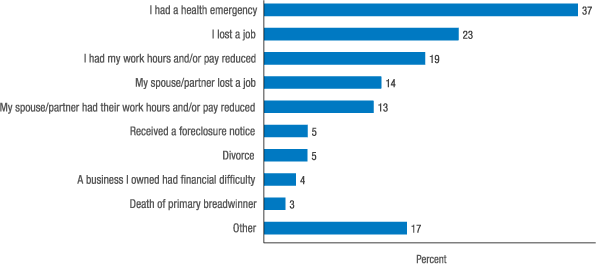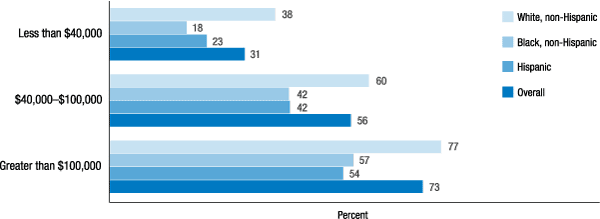Report on the Economic Well-Being of U.S. Households in 2014
- Preface
- Executive Summary
- Introduction
- Overall Economic Well-Being
- Housing and Household Living Arrangements
- Economic Fragility and Emergency Savings
- Savings and Spending
- Banking, Credit Access, and Credit Usage
- Education and Student Loans
- Retirement
Economic Fragility and Emergency Savings
A key consideration regarding household finances and overall economic well-being is the ability to withstand financial disruption. Almost a quarter of respondents indicate that they experienced some form of financial hardship in the year leading up to the survey, and the results demonstrate that households throughout the income distribution struggle to maintain a financial safety net that could minimize the repercussions from such events. This lack of a financial safety net is reflected in economic behaviors, as respondents report leaning on friends or family to overcome financial hardships or report going without medical treatment due to an inability to pay.
Financial Hardships
Twenty-four percent of respondents indicate that either they, or their family living with them, experienced some form of financial hardship in the previous year. Among those who experienced a financial hardship, 35 percent report that either they or their spouse lost a job--including 2 percent who indicate that both they and their spouse lost a job. Twenty-nine percent say that either they or their spouse had their work hours cut, 37 percent had a health emergency, and 5 percent received a foreclosure or eviction notice (figure 6). Additionally, 27 percent of those experiencing hardships say they received financial assistance from friends or family in the past year, which illustrates the importance of social networks in weathering economic setbacks.
Figure 6. Which of the following economic hardships did you or your family living with you experience in the past year?

Note: Among respondents who report that they experienced an economic hardship in the past year.
Return to textEmergency Savings
Recognizing the frequency with which individuals experience some form of financial hardship, the survey asks respondents several questions to understand their ability to withstand emergencies of varying levels of severity. Although the results vary by the severity of the emergency presented, many households appear ill-prepared for financial emergencies.
When asked if they have set aside an emergency or rainy day fund that would cover three months of expenses, only 45 percent of respondents indicate that they do. However, it is possible that personal savings alone do not fully reflect the way that individuals prepare for such a large financial disruption. To capture the possibility that many individuals' approach for weathering a severe disruption includes other strategies, the survey asks respondents who indicate that they do not have three months of emergency savings on hand a follow-up question, "If you were to lose your main source of income (e.g., job, government benefits), could you cover your expenses for 3 months by borrowing money, using savings, selling assets, or borrowing from friends/family?" An additional 21 percent of respondents indicate that they could cover three months of expenses using this broad array of options.
When combining the 21 percent of respondents who could cover three months of expenses using assets or borrowing with the 45 percent who could cover three months of expenses using their personal savings, 66 percent of all respondents report that they are prepared for a three-month financial disruption. However, 32 percent of respondents are not prepared for a three-month long financial disruption and could not cover their expenses in such a situation, even by borrowing.
To determine individuals' preparedness for a smaller-scale financial disruption, respondents are also asked how they would pay for a hypothetical emergency expense that would cost $400. Just over half (53 percent) report that they could fairly easily handle such an expense, paying for it entirely using cash, money currently in their checking/savings account, or on a credit card that they would pay in full at their next statement (referred to here as "cash or its functional equivalent"). The remaining 47 percent indicate that such an expense would be more challenging to handle. Specifically, respondents indicate that they simply could not cover the expense (14 percent); would sell something (10 percent); or would rely on one or more means of borrowing to pay for at least part of the expense, including paying with a credit card that they pay off over time (18 percent), borrowing from friends or family (13 percent), or using a payday loan (2 percent).
The approach to paying a $400 emergency expense varies substantially by income, and by the race and ethnicity of the respondent. Only 31 percent of respondents whose household income is under $40,000 would pay the $400 expense using cash or its functional equivalent, whereas 56 percent of respondents in the middle income group and 73 percent of respondents making over $100,000 would pay this way (figure 7). Similarly, while 59 percent of white respondents say that they would pay such an expense using cash or its functional equivalent, only 37 percent of Hispanic respondents and 33 percent of black respondents would pay this way.
Respondents who indicate that they would pay the $400 expense exclusively using resources other than cash or its functional equivalent are also asked what the largest expense is that they could cover using cash on hand or money in their bank account. Thirty-nine percent of these respondents report that the largest expense that they could cover using cash on hand is under $100. A further 16 percent indicate that they could only cover an expense between $100 and $200, and 22 percent could cover an expense between $200 and $400. The remaining 22 percent report that they could cover over a $400 expense--suggesting that for this subset of respondents, paying the $400 expense using other means reflects a preference of payment methods rather than a necessity.
Figure 7. Percent of respondents who would completely pay an emergency expense that costs $400 using cash or a credit card that they pay off at the end of the month (by race/ethnicity and household income)

Health-Care Expenses
Although emergency expenses can take many forms, out-of-pocket expenses for health care are a particular concern for many respondents. Almost a quarter of respondents experienced what they describe as a major unexpected medical expense that they had to pay out of pocket in the 12 months prior to the survey.
Many respondents also report that they went without some type of care because they were unable to afford it. One quarter of respondents went without dental care in the prior 12 months because they could not afford it. Fifteen percent went without a doctor visit, 13 percent went without prescription medicine, and 11 percent went without a visit to a specialist (figure 8). Overall, 31 percent of respondents report going without at least one of these types of care because they could not afford it.
Figure 8. During the past 12 months, was there a time when you needed any of the following, but didn't get it because you couldn't afford it?

The likelihood of foregoing medical care due to cost is strongly related to one's income. Among respondents with a household income under $40,000, 45 percent report that they had gone without some form of medical treatment in the preceding 12 months. This fraction is 31 percent among respondents with incomes between $40,000 and $100,000, and just 16 percent among respondents making over $100,000.
Similarly, cash on hand is closely related to the decision to forego medical treatment due to the cost. Of the people who would not cover a $400 emergency expense using cash or its functional equivalent, 47 percent also avoided medical treatment because of the cost. In comparison, just 17 percent of respondents who would cover the $400 emergency expense using cash or a credit card that they pay in full at the next statement report avoiding medical treatment because of the cost.
One potential avenue for alleviating this inability to cover health care expenses is through health insurance, which can reduce the probability of large expenses and/or reduce the expected size of such expenses. According to the survey, 89 percent of respondents were covered by some type of health insurance or health coverage plan when the survey was conducted, which is up from 85 percent who were insured in the 2013 survey. Approximately 3 percent of respondents report receiving their insurance through a Health Insurance Exchange. The 89 percent of respondents with health insurance coverage includes approximately 87 percent of people ages 18 to 64 who are insured, and more than 99 percent of people over age 65 who have health insurance (table 8).
| Age categories | Not insured | Insured |
|---|---|---|
| 18-29 | 14.8 | 81.3 |
| 30-44 | 12.4 | 86.5 |
| 45-64 | 8.7 | 91.0 |
| 65+ | 0.9 | 99.1 |
| Overall | 9.5 | 89.3 |
| Total number of respondents | 5,896 |
However, while having health insurance reduces the probability of foregoing medical treatment due to an inability to pay, it does not eliminate it. Among uninsured respondents, 48 percent report that they had gone without some form of medical treatment in the preceding 12 months. In comparison, 30 percent of respondents who have health insurance report that they went without some form of medical treatment in the same period.8
The impact of insurance on the likelihood of missing medical treatments differs based on one's income. Among respondents with incomes below $40,000, those with health insurance are only 7 percentage points less likely to have foregone medical treatment than those who are uninsured (figure 9). This is well below the impact from insurance for those in the higher-income groups. This might partially reflect that some health insurance does not cover all health expenses, such as dental care, which may therefore be unaffordable to low-income respondents regardless of their health insurance status. But it may also reflect that copayments and coinsurance are sufficiently large that they represent a barrier to medical treatment for many low-income individuals, including some of those who are insured.
Figure 9. Did you need some form of medical treatment in the past 12 months, but did not get it because you could not afford it? (by household income and health insurance status)

References
8. Since the survey asks respondents about their current health insurance status, but also asks about whether they missed medical treatments in the previous year, it is possible that some respondents who currently have insurance were uninsured at the point at which they were unable to afford treatment. Return to text
